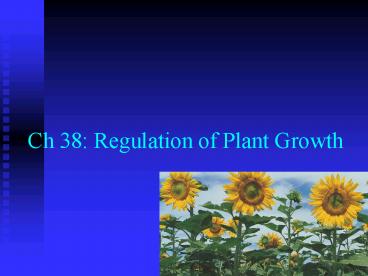Ch 38: Regulation of Plant Growth PowerPoint PPT Presentation
1 / 24
Title: Ch 38: Regulation of Plant Growth
1
Ch 38 Regulation of Plant Growth
2
Figure 38.4 Embryos Mobilize Their Reserves
3
Plant hormones
- Hormone chemical signals that coordinate parts
of an organism produced in one part of the body
and then transported to other parts of the body
low concentrations - Tropism movement toward or away from a stimulus
- Went experiments (phototropism)
- Hormone auxin
- Others gravitropism, thigmotropism
4
Auxin
- IAA (indoleacetic acid)
- Location seed embryo meristems of apical buds
and young leaves - Function stem elongation root growth,
differentiation, branching fruit development
apical dominance tropisms
5
Auxin Affects Plant Growth and Form
- Phototropism is the tendency for plants to grow
toward light sources. - In the 1800s, Charles Darwin and his son Francis
experimented with canary grass seedlings grown in
the dark. - They found that when the top millimeter of the
coleoptile of a grass plant is covered, the plant
cannot respond to the direction of light. - The photoreceptors are in the coleoptile tip.
However, the bending takes place in the growing
region below the tip. A signal must pass from the
tip to the growing region.
6
Figure 38.7 The Darwins Phototropism Experiment
(Part 1)
7
Figure 38.7 The Darwins Phototropism Experiment
(Part 2)
8
Figure 38.8 Wents Experiment
9
Auxin Affects Plant Growth and Form
- The movement of auxin is polarit travels in just
one direction along a line from apex to base. - This movement is not due to gravity. The apex to
base direction is not reversed by inverting
plants. - Polar transport depends on auxin anion efflux
carriers, membrane proteins found only at the
basal ends of cells. - At pH 7 in the cytoplasm, auxin exists as an
anion. Auxin anions can leave the cell only by
way of the protein carriers.
10
Auxin Affects Plant Growth and Form
- The lateral redistribution of auxin is involved
in both phototropism and gravitropism. - Redistribution occurs when the carrier proteins
move to one side of the cell and allow exit of
auxin only on that side. - When light strikes a coleoptile from one side,
the auxin moves to the shaded side, growth on
that side is increased, and the seedling bends
towards the light. - If a shoot is tipped over, auxin moved to the
lower side and causes more rapid growth there.
The seedling bends upward.
11
Figure 38.10 Plants Respond to Light and Gravity
12
Auxin Affects Plant Growth and Form
- Auxin affects plant growth in many ways
- Initiating root growth
- Inhibiting leaf abscission
- Maintaining apical dominance
- Promoting stem elongation and inhibiting root
elongation - Controlling fruit development
13
Auxin Affects Plant Growth and Form
- Shoot cuttings can produce roots if
undifferentiated cells in the shoot can be
induced to differentiate into the meristem of a
new root. - Shoot cuttings of many plant species develop
profuse roots when the cut surfaces are dipped
into an auxin solution. - This observation suggests a role for auxin in the
initiation of lateral roots. - Commercial rooting powders usually contain
synthetic auxin.
14
Auxin Affects Plant Growth and Form
- Apical dominance is the tendency for lateral buds
to remain dormant. Apical buds inhibit the growth
of lateral buds. - Removing apical buds stimulates lateral bud
growth. - If auxin is applied to the cut surface in place
of the apical bud, the lateral buds are inhibited.
15
Figure 38.12 Auxin and Apical Dominance
16
Auxin Affects Plant Growth and Form
- Auxin stimulates stem elongation but inhibits
root elongation. Why different organs respond
differently to the same hormone is a subject of
current research. - In many species, treatment of unfertilized
ovaries with auxin or gibberellins causes fruit
formation. - This process is called parthenocarpy and is
useful in the production of seedless fruits.
17
Auxin Affects Plant Growth and Form
- Synthetic auxins have been produced and studied.
- One of them, called 2,4-D, is lethal to eudicots
at concentrations that are harmless to monocots. - This auxin has been used as a selective herbicide
on lawnsgrasses are monocots, and most of the
weeds in lawns are eudicots. - 2,4-D takes a long time to break down, however,
so it pollutes the environment.
18
Cytokinins
- Zeatin
- Location roots (and actively growing tissues)
- Function root growth and differentiation cell
division and growth germination delay
senescence (aging) apical dominance (w/ auxin)
19
Gibberellins
- GA3
- Location meristems of apical buds and roots,
young leaves, embryo - Function germination of seed and bud stem
elongation leaf growth flowering (bolting)
fruit development root growth and differentiation
20
Figure 38.5 The Effect of Gibberellins on Dwarf
Plants
21
Abscisic acid
- ABA
- Location leaves, stems, roots, green fruit
- Function inhibits growth closes stomata during
stress counteracts breaking of dormancy
22
Ethylene
- Gaseous hormone
- Location ripening fruit tissue stem nodes
aging leaves and flowers - Function fruit ripening oppositional to auxin
(leaf abscission) promotes/inhibits
growth/development of roots, leaves, and flowers
senescence
23
Daily and Seasonal Responses
- Circadian rhythm (24 hour periodicity)
- Photoperiodism (phytochromes)
- Short-day plant light period shorter than a
critical length to flower (flower in late summer,
fall, or winter poinsettias, chrysanthemums) - Long-day plant light period longer than a
critical length to flower (flower in late spring
or early summer spinach, radish, lettuce, iris) - Day-neutral plant unaffected by photoperiod
(tomatoes, rice, dandelions) - Critical night length controls flowering
24
Phytochromes
- Plant pigment that measures length of darkness in
a photoperiod (red light) - Pr (red absorbing) 660nm
- Pfr (far-red absorbing) 730nm

